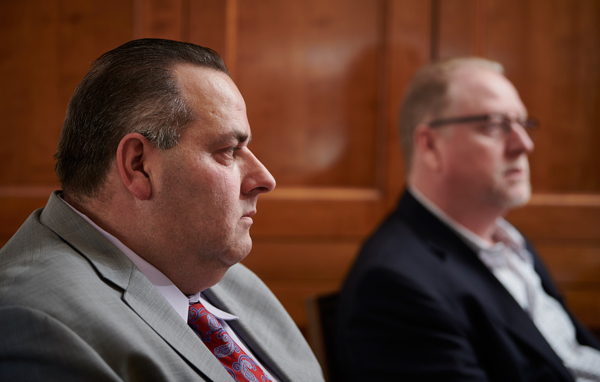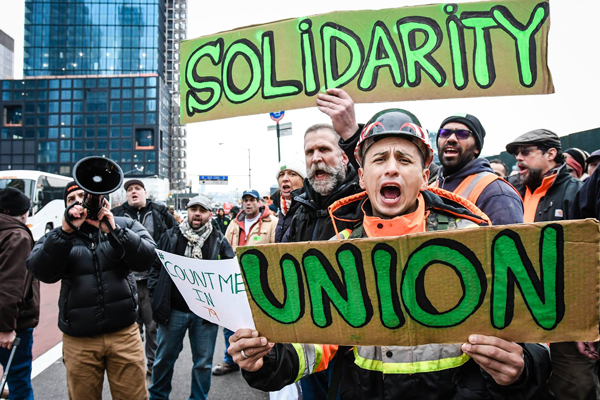Trending
Can the city carpenters’ union overcome its shady past?
The union is trying to shake its old reputation and wean itself off court supervision, all while trying to stay competitive as open shops encroach on its market share

For decades, the New York City District Council of Carpenters was seen as a carousel of leaders-turned-criminals.
Between 1982 and 2013, five of the organization’s top leaders were removed or resigned for crimes ranging from bribery to embezzlement. Theodore Maritas’ tenure met the grisliest end: On the eve of his trial on mob-related extortion charges in 1982, the former union head disappeared. He was never found, but his wallet was discovered a few days later in a shallow part of the East River near the Throgs Neck Bridge.
Eight years later, the U.S. Attorney’s Office launched a federal lawsuit against the carpenters’ union alleging that its managing team was corrupt and had engaged in racketeering. In 1994, the group agreed to the supervision of an independent monitor, and it’s had one ever since.
The union was not an anomaly at the time — a New York Times article from the late ‘90s called New York City the “national capital of union corruption,” noting that one-fourth of the city’s union workforce had been under trusteeship at some point in the previous two years. But even up until 2011, the union’s monitor had found it had strong ties to the mob.
Now the council’s leadership is trying to distance itself from its seedy past. Its executive secretary-treasurer, the highest position in the organization, Joseph Geiger, was re-elected in December 2017, marking his second full term and fifth year at the helm of the 20,000-plus member group. He works alongside the union’s president, Stephen McInnis, and vice president, Michael Cavanaugh, both of whom were also re-elected. In recent years, the group’s executive team hired more internal watchdogs, changed how shop stewards report hours worked (it’s now handled electronically) and began hosting monthly meetings to discuss how to best manage relationships with developers and contractors.
“That whole corruption, big bad union thing? It’s all gone. We don’t want that stigma anymore,” Geiger told The Real Deal during an interview at the organization’s Hudson Street headquarters in January. “It’s gotten to the point where a business representative will call up the chief compliance officer if someone offers him a cup of coffee, because you’re not supposed to take anything from a contractor.”
The carpenters’ union is now working to wean itself off court supervision. Its latest monitor, Glen McGorty, recommended in an April 2017 report that the organization make the transition toward self-governance, noting that the leadership showed a “genuine desire to achieve a prosperous and compliant future.” McGorty’s contract expires March 31, and it seems likely that his role will be reduced.
As the group works to shed its checkered past, it’s positioned itself as one of the few unions willing to work with developers to cut costs as nonunion shops continue to eat into its market share. The carpenters’ union has managed to keep its grip at Related Companies’ $25 billion, 28-acre Hudson Yards project, despite the developer going open shop for the remainder of the development. At the same time, the union is clashing with developers on such issues as construction safety and with the city over benefits.
In many ways, it’s a pivotal moment for the group: Its members are navigating a market in which unions are no longer the first choice while also trying to reshape the narrative of a historically corrupt organization.
 McGorty’s predecessor, Dennis Walsh, said that when he was brought in to monitor the union in 2010, there were “obviously still people who were problematic,” but that they were a symptom of a larger problem.
McGorty’s predecessor, Dennis Walsh, said that when he was brought in to monitor the union in 2010, there were “obviously still people who were problematic,” but that they were a symptom of a larger problem.
“It was the business practices [that needed to change],” he said. “My impression from day one was this thing needed to be transformed.”
State of affairs
“Carpenters” union, as it turns out, is a bit of a misnomer. The council — a local division of the United Brotherhood of Carpenters, one of the largest building trades unions in North America — comprises nine local unions, which work with a range of materials, including metal, concrete, drywall and flooring, in addition to wood.
For obvious reasons, all of this makes the group indispensable to the city’s developers. But the growing dominance of nonunion work in the city is one of the biggest threats to the carpenters’ union. By the union’s own estimations, nonunion shops work on nearly half of the new residential projects in the city and are beginning to encroach on the commercial sector as well. At the same time, overall union membership among construction companies has dropped precipitously within the past four decades. As of 2017, only 24.4 percent of private construction workers in New York State were union members, according to unionstats.com, an internet database that provides private and public sector union membership estimates. In the 1980s, that number was closer to 50 percent.
The carpenters’ union, which was founded in 1918, has seen a 21 percent drop in membership since 2008, when the group represented 25,515 workers in NYC. By June 2017, that total had fallen to 20,219.
Those numbers have been a point of contention for the union — and understandably so. The “prevailing wage” for publicly funded construction projects, for example, is often calculated based on what at least 30 percent of workers in a given trade are being paid. So, inflated membership numbers could have an impact on how that wage rate is calculated, according to the Associated Builders and Contractors (ABC) trade association.
In 2015, ABC, which represents open-shop contractors, called on city Comptroller Scott Stringer to investigate the union because the group misstated the size of its membership on its website. At the time, the website claimed that the membership was at 25,000, even though its report with the Department of Labor showed it had 18,987 members, Politico reported. The website still boasts the inflated number, and it doesn’t appear that any investigation came from ABC’s complaints. ABC declined to be interviewed for this story.
“It’s hard for any union to determine the exact number of members at any given point, especially an organization as large as ours,” Geiger said. But he called the characterization of a membership decline “misleading.”
The union’s leadership instead pointed to hours logged as an indication of the group’s true clout in the city. “In 2011, we were at 16 million hours, now we’re close to [25 million] hours,” Cavanaugh, the group’s VP, said. “Membership doesn’t reflect market share.”
Disunion
For several weeks in December and January, protesters gathered on 34th Street across from Related’s 50 Hudson Yards, where excavators and bulldozers are pushing aside massive piles of dirt to make way for the glassy office tower. The picketers came from a handful of trades and were calling for solidarity among different unions to boycott the development unless Related kept nonunion shops off the site.
But the carpenters’ union didn’t align with the other trades. Its sign hangs over one side of the 50 Hudson Yard’s perimeter declaring: “We Build New York.” Vendors outside the nearby No. 7 subway station sell sweatshirts emblazoned with the carpenters’ logo, along with hats with Day-Glo skulls and the local unions’ numbers.
Geiger said the call for solidarity this time came late: The union already had a contract to do foundation work at the site. Backing out of a deal and putting workers out of a lucrative job was too tall an order.

Union members protested outside Related Companies’ 50 Hudson Yards site
“The bottom line is it’s about putting our members to work. It’s a 3 million-square-foot building,” Geiger said. “Not every job in the city has the support of all the trades. There’s other jobs that they’re working on that we’re not working on. We just don’t make a big deal out of it.”
Gary LaBarbera, president of the Building and Construction Trades Council of Greater New York — which the union is a member of — maintained that the carpenters’ position doesn’t negatively affect its relationship with his organization. “The reality is, [the carpenters] made a decision that is different than the decision that the rest of the council has made,” he said. “This will happen from time to time in any organization.”
The Hudson Yards project is one of the most prominent examples of how the carpenters’ union has clung to its market share. And developers who spoke to TRD said it’s one of the few unions willing to reduce costs to stay competitive.
Three years ago, the carpenters’ union started diversifying the skill level of its laborers, encouraging its members to start pairing two less-skilled, “provisional” journeymen — at $57.57 per hour — for every two skilled journeyman — at $93 per hour on the job (that number includes benefits). The idea is to shave the bottom line without cutting pay for individual workers.
“By doing that, they have made themselves competitive to open-shop high-rise carpentry competitors,” said Jeff Levine, chairman of local development firm Douglaston Development and Levine Builders. He said Local 212 — the high-rise concrete workers’ union within the carpenters’ guild — employed this blended rate system when it worked on his mixed-use project at 2 North Sixth Street in Williamsburg. “They have been very intelligent in being responsive to the market. They realize if they don’t adapt, they will not be in the future of the building business.”
LaBarbera noted that other unions, including the plumbers, steamfitters and sheet metal workers, have implemented similar programs. He said the carpenters’ union just seems to be marketing this more aggressively to developers.
But compared to nonunion workers — who are often paid less than $30 an hour according to an analysis by the union — the carpenters charge a pretty penny.
“If you think you can build affordable housing paying carpenters $187,000 a year, you are sorely mistaken,” said the Durst Organization’s Jordan Barowitz about the high cost of paying both salary and benefits for the workers. He suggested that public subsidies could make paying those carpenters’ salaries more doable.
There are some places the union, like others, struggles to reduce overhead. The council met with the Real Estate Board of New York a few times late last year to discuss ways to rein in costs when it comes to high-rise concrete work and project-specific general liability insurance. Geiger and his associates declined to comment on that.
Yet one thing remains clear: The carpenters’ union will go to great lengths to assure that its locals are hired.
“They are aggressive about maintaining market share. They will launch a coordinated effort to get what they need,” said one major construction contractor on the condition of anonymity.
Policy powerhouse
While the carpenters’ union has been making moves to better cater to developers’ needs, its relationship with New York’s real estate crowd is by no means harmonious. In recent years, the union has pitted itself against developers on a slew of major initiatives, from ensuring prevailing wage in the revised 421a tax abatement to a contentious construction safety bill that requires workers to get at least 40 hours of additional safety training.
These battles have earned the union — or at least its president, McInnis — a certain reputation. One source noted that while Geiger seems willing to negotiate, McInnis is the “type of guy who just wants to fight.”
When asked about these good-cop, bad-cop personas in January, the two leaders, who are no strangers to having people making assumptions about their personalities, laughed and shrugged. During TRD’s visit to the district council’s office, Geiger was gregarious, cheerfully greeting employees with a slap on the shoulder. McInnis, who spoke in a softer voice, offered only one explanation for the perception that he’s more combative than his counterpart.
“There are some in the real estate industry who blame me for [wage rates making it into the revised] 421a,”McInnis said. “So that may be where that’s coming from.”
Now the carpenters’ union is in the midst of another battle. It’s suing Mayor Bill de Blasio’s administration, which the group alleges violated the Triborough Doctrine — a law that prevents the city from threatening to cut benefits in exchange for union workers not striking. Last year, McInnis said the city cut sick leave and retirement benefits from 700 members.
“They implemented one sick day a year,” McInnis said. “That’s against the law in New York City, the law that the mayor advocated for as a City Council member, for five sick days a year. It doesn’t sound like something a pro-labor mayor should be doing.”
Freddi Goldstein, a spokesperson for the mayor, said that the city’s reached an agreement with “99 percent” of the unions over healthcare costs, but that “the carpenters are one of the last remaining unsettled groups, even though they have been offered the same fair deal that was good enough for practically everyone else.”
Internal struggles
The union continues to fight for its constituency at City Hall and in Albany, but it’s had its fair shares of internal battles as well. Most recently, in October, Samuel Perry, a disgruntled member of local 212 walked into work and fatally shot his supervisor, Christopher Sayers, at Waterline Square, a luxury condominium project being developed by GID Development. He then turned the gun on himself.
While that extreme event was seemingly beyond the organization’s control, a slew of other incidents might not be.
In 2014, the union was hit with a lawsuit accusing the organization of harassing Creative Construction — a minority-owned contractor that worked with the union on a new academic building at Columbia University. Hanson James, the founder of the construction company, alleged that the union also sent subpar workers to his sites after he complained that one of the organization’s local boards was made up of all white men.
That lawsuit was settled in March 2017, but James says the action was indicative of the union’s tendency to intimidate anyone it deems as a threat. “It was open season on me,” James said. “Their goal was to destroy my company.”
Meanwhile, Michael Donnelly, a labor organizer for the council, was fired in May after inspecting a Rockaway Park site owned by Charles McInnis, the union president’s brother. He notified the Department of Buildings about violations at the property, which ultimately drew attention to the fact that Charles used some nonunion labor on his project. One union member familiar with Donnelly’s firing said he had no doubt he was terminated because of his work at McInnis’ site. “It’s his brother,” he said. “Blood is thicker than water.”
When TRD asked about the incident in June, McInnis said the fact that his brother hires nonunion labor has no bearing on his own dedication to the cause. “My sister owns a restaurant. Does that mean I’m in the restaurant business? It’s ridiculous,” he said.
Last month, Geiger explained that the incident was “not as exciting as some may try to make it out to be,” and that “this was the firing of an organizer, who was chronically insubordinate. We took the same actions we would with any organizer we had the same issue with.”
Other accusations against the union have called working conditions into question. Veronica Session, a member of one of the council’s local chapters and a carpenter for nearly 30 years, pointed to issues stemming from 2013, when the organization implemented its “full-mobility” policy. The policy allows contractors to bypass the union’s out- of-work list when hiring. Previously, contractors were required to hire at least 33 percent of their workforce from that list.
Session said the change has made contractors less stringent about safety regulations and about rules that require companies to provide workers with all their necessary construction tools. She said the prevailing attitude is: If the workers don’t like the conditions, they can easily be laid off and replaced because companies no longer have to worry about meeting a certain ratio.
Session said the current working conditions don’t give her much confidence in the organization’s future. “You know the [union’s] history,” she said.
Geiger argued those issues aren’t due to full mobility, and that unsafe working conditions are “the result of a contractor not playing by the rules.”
Bridge over troubled waters
As the end of McGorty’s contract approaches, the union’s future mostly looks bright. Geiger said he expects McGorty to stay on, at least until the union’s new inspector general (who is intended to take over some of the monitor’s tasks) gets more experience.
The monitor’s latest report, though mostly sunny, noted that the union’s compliance officer conducted an investigation into an allegation of “vendor misconduct during an RFP process” and found that the accusation was substantiated. Representatives for the council said that fell under the jurisdiction of the group’s pension funds, which could not be reached for comment.
Walsh, the previous monitor, said the union has come a long way in the last eight years. During his tenure, the union implemented a series of safeguards to prevent the organization from falling into its old ways. The council created its two internal watchdog positions: chief compliance officer and inspector general. Though these individuals are on the council’s payroll, Walsh noted that the bylaws created an important protection: Before a person in either position is fired, the U.S. Attorney’s Office must be notified. Term limits on the union’s leadership have also been put in place. Meanwhile, the union spends $4 million annually on anti-corruption measures and policies, according to Geiger.
“It takes committed and strong leadership to overcome what happened in the past,” said Lou Coletti, president and CEO of the Building Trades Employer Association, whose organization is made up of companies that often hire carpenters’ union members. “And I think that that’s what the carpenters’ union has done in the past four or five years.”
In addition to its internal policing, the union has made inroads when it comes to technology and training. Walsh noted that the shift in how shop stewards record hours went a long way in eliminating the “insidious racketeering” that overwhelmed the organization back in 2010. Moving the information online and making it available to everyone working on a site created an accountability that wasn’t there before, he said.
“I believe that they have the infrastructure, in terms of rules and procedures, that will enable them to [be self-governed],” Walsh said. “You cannot have an entity that is continuously self-monitored. Then there’s no incentive for improvement.”



